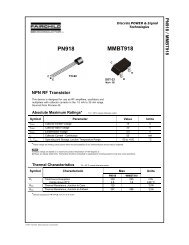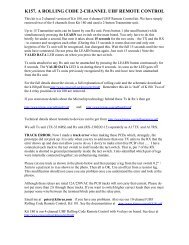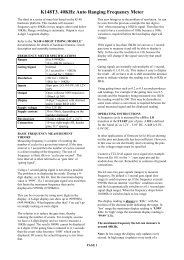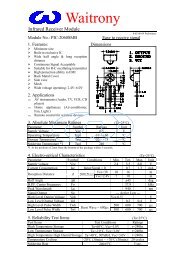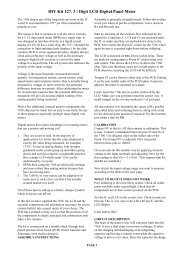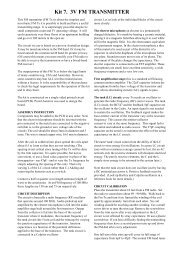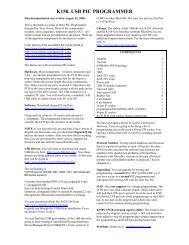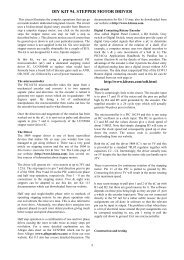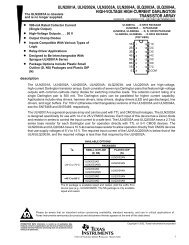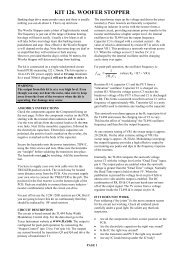Kit 57. ION GENERATOR - Electronics123.net
Kit 57. ION GENERATOR - Electronics123.net
Kit 57. ION GENERATOR - Electronics123.net
You also want an ePaper? Increase the reach of your titles
YUMPU automatically turns print PDFs into web optimized ePapers that Google loves.
<strong>Kit</strong> <strong>57.</strong> <strong>ION</strong> <strong>GENERATOR</strong><br />
An ion generator or ioniser is a device which creates ions<br />
and puts them into the air. A high negative voltage of<br />
around 5000V will make negative ions and a high positive<br />
voltage will make positive ions. There are supposed to be<br />
health and other benefits about living in an environment<br />
which has an excess of negative ions. This is a topic we<br />
will return to at the end of this documentation.<br />
The simplest and easiest way to generate ions is to use a<br />
Cockroft-Walton multiplier circuit. This is a string of<br />
diodes and capacitors in a succession of voltage doubling<br />
circuits. See the figure below. The diodes and ceramic disc<br />
capacitors are readily available components with a high<br />
long term reliability.<br />
NOTE: this project MUST be mounted in an enclosed box<br />
or container for THREE reasons:<br />
• the first is that it is mains powered. It must be kept<br />
protected from people accidently touching it. The<br />
mains cable must be firmly secured by the usual<br />
means.<br />
• second, is that it has a chain of voltage doubling<br />
circuits. At the end of the chain (at C30) you do not<br />
have to touch a component to get a shock. A spark<br />
will jump across about 3mm to get you. (The shock is<br />
really just a tickle and it is more a surprise than<br />
anything else.)<br />
• third, the final stage of the ion generator - the three<br />
resistors & the pin farm - must be suspended in the air<br />
and not near or touching a solid surface. Ions are<br />
funny things. At the high voltages but very low<br />
currents available the ions will collect on particles<br />
(dust) and solid surfaces. If the pin farm & protection<br />
resistors are on a surface (plastic, newspaper) the<br />
ions will not be generated.<br />
Also note that if you are sitting in a well insulated, dry<br />
chair then there is no shock if you accidently touch the<br />
pins on the pin farm when the generator is in operation.<br />
You do not have to worry that when you listen to the ions<br />
being generated that you will get a huge shock if you<br />
accidently touch a pin. We are not suggesting you<br />
deliberately start feeling the pins. And do not touch the<br />
components in the doubling chain what ever you do.<br />
The circuit as presented is designed to generate negative<br />
ions. However, by simply reversing all the diodes, D1 to<br />
D30, in the ladder you automatically make it into a positive<br />
ion generator. This gives you an easy way to test for<br />
yourself whether negative ions and/or positive ions affect<br />
mood, performance etc. You may buy two of these kits and<br />
construct one as a negative ion generator and the other as<br />
a positive ion generator. Then put them in different<br />
situations either with or without people knowing. Leave<br />
them on for several days and note any changes or<br />
alteration in behaviour.<br />
Design<br />
Commercial designs usually use a transformer to raise the<br />
initial voltage from either mains or battery voltages up to<br />
about 1KV. Then they have about 5 voltage multiplier<br />
stages feeding a pin farm of 3 or 4 pins.<br />
We chose the design shown in the Figure because it uses<br />
more readily available components. There are 30 diodes<br />
and 30 capacitors. A 0.1A fuse is included in the event of<br />
component failure in the chain. A neon is provided to<br />
show when the unit is on. The resistor R2 rapidly<br />
discharges the chain when the power is turned off. It is<br />
important to realize that nothing like the theoretical<br />
voltage of the chain is achieved in practice. The regulation<br />
is poor & the impedence is high. The final three resistors<br />
leading to the pin farm are for safety<br />
if you touch the emitting pins.<br />
Construction<br />
Components may be added to the board in any order. The<br />
most important thing to watch is that all the diodes are put<br />
in the correct way. Follow the overlay pattern to make a<br />
negative ion generator. Reverse all the diodes to make a<br />
positive ion generator. Use some of the cut off legs from<br />
the capacitors for the 5 pins in the pin farm. The fficiency<br />
of the pins can be increased by filing their tips to a point.<br />
You must mount the PCB in a suitable box. The pins<br />
should be positioned so they almost stick out from the box<br />
into the air. No solid surfaces (like plastic) should be near<br />
or next to the track leading from C30 to R3 R4 & R5 & the<br />
pin farm. Any solid surfaces touching this output will<br />
reduce ion generation efficiency. You can put silicon gel<br />
on the bottom layer if you have it.<br />
Since ions are generated from sharp points it is a good<br />
idea to check the soldering of the resistors & pins in the<br />
output track. Make sure the solder joint is rounded and<br />
covers the cut-off ends of the resistors & pins.<br />
Testing<br />
When power (either way around) is connected the neon<br />
will light and after a few seconds (4 to 10 seconds) you<br />
will hear a faint hiss from the pins. This is the ions being<br />
injected into the air. As mentioned it may not work if the<br />
board is sitting on plastic, wood or newspaper. The output<br />
track must be isolated. If you wet you finger and place it<br />
near the end of the pins you will also feel the ion wind.<br />
You will not get a shock if you accidently touch a pin. But<br />
make sure you are on an insulated surface. Remember how<br />
a nylon shirt will crack sparks if you rub it with wool in the<br />
dark. There are thousands of volts being made there and<br />
the sparks are being made on you yet you feel no shock.<br />
The volts are there but not the current.<br />
If you are tempted to try multimeter voltage measurements<br />
of the chain you will quickly find it does not work. The
<strong>Kit</strong> <strong>57.</strong> <strong>ION</strong> <strong>GENERATOR</strong><br />
voltages are but there is too little current to power the<br />
meter.<br />
If It Does Not Work. Check that the diodes are all in the<br />
correct way. Are the resistors in the right places. Did you<br />
put the fuse in. Use a multimeter to check each diode & a<br />
capacitance meter to check each capacitor.<br />
Ozone. After a few hours operting in a small room you<br />
may find that there is a funny smell present. You may<br />
recognise it as a 'machinery' smell. This is ozone gas. It is<br />
produced in high voltage switching machinery such as<br />
generators. It is also given off by rotting seaweed. (Indeed<br />
in the last century people in England used to flock to the<br />
seaside to smell the ozone. It was thought to be good for<br />
you.) If the ion generator produces too much ozone then<br />
we suggest you jumper the pin farm track from C30 to C28<br />
or C26. That is you cut out the<br />
last one or two voltage doubling stages.<br />
COMPONENTS<br />
0.01uF 1KV ceramic capacitor 30<br />
1N4007 diode 30<br />
2 pole terminal block 1<br />
Fuse 0.1A 1<br />
Fuse holder & cap 1<br />
Neon 1<br />
Resistors 5%, 1/4W:<br />
3M3 orange orange green 4<br />
100K brown black yellow 1<br />
K57 PCB 1<br />
Are Negative Ions of Benefit to You? Quite a bit of<br />
research has gone into this topic. Research ranges from<br />
the quack pseudo-scientific to the reputable. A list of<br />
some papers from the latter group is given here. In<br />
summary, there is no evidence that negative ions have any<br />
effect on well being however it is defined. The claims by<br />
commercial producers of negative ion generators that their<br />
products enhance efficiency, increase productivity and<br />
contribute to personal health are unsupported by<br />
scientific evidence. However, if you think something is<br />
going to do you good then it may in fact do so; this is the<br />
placebo effect. And alot of research in the 1990's has gone<br />
into it. But that is another story.<br />
Baron, Robert A. (1987). Effects of Negative Ions on<br />
Interpersonal Attraction: Evidence for Intensification.<br />
Journal of Personality & Social Psychology,52 (3), 547-<br />
553.<br />
Baron, Robert A. (1987). Effect of Negative Ions on<br />
Cognitive Performance. Journal of Applied Psychology,<br />
72, 131-137.<br />
Dolezalek, Hans. (1986). Atmospheric Electricity, Ions, and<br />
Pseudoscience. The Skeptical Enquirer, 11, 56-60. See<br />
follow-up article by James Rotton in the same journal<br />
(1987) 11, 305-306.<br />
Web<br />
Plug in ‘ion generator’ in yahoo.com and you will come up<br />
with commercial and semi-scirntific References to them.<br />
They make interesting reading.
<strong>Kit</strong> <strong>57.</strong> <strong>ION</strong> <strong>GENERATOR</strong>



